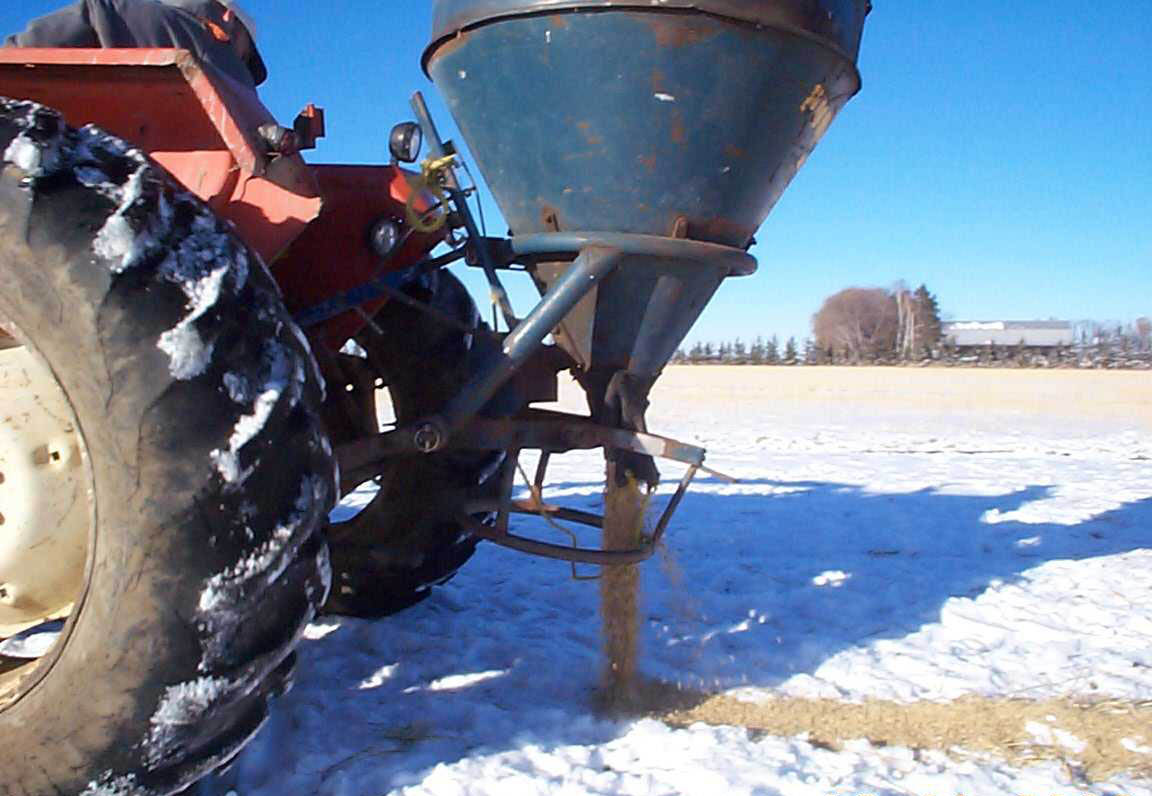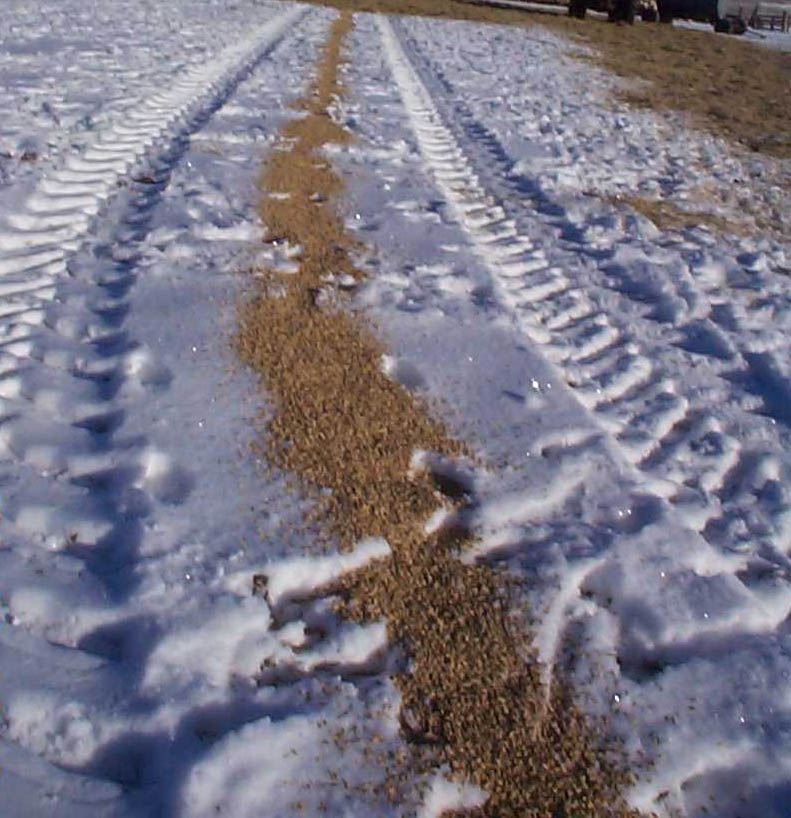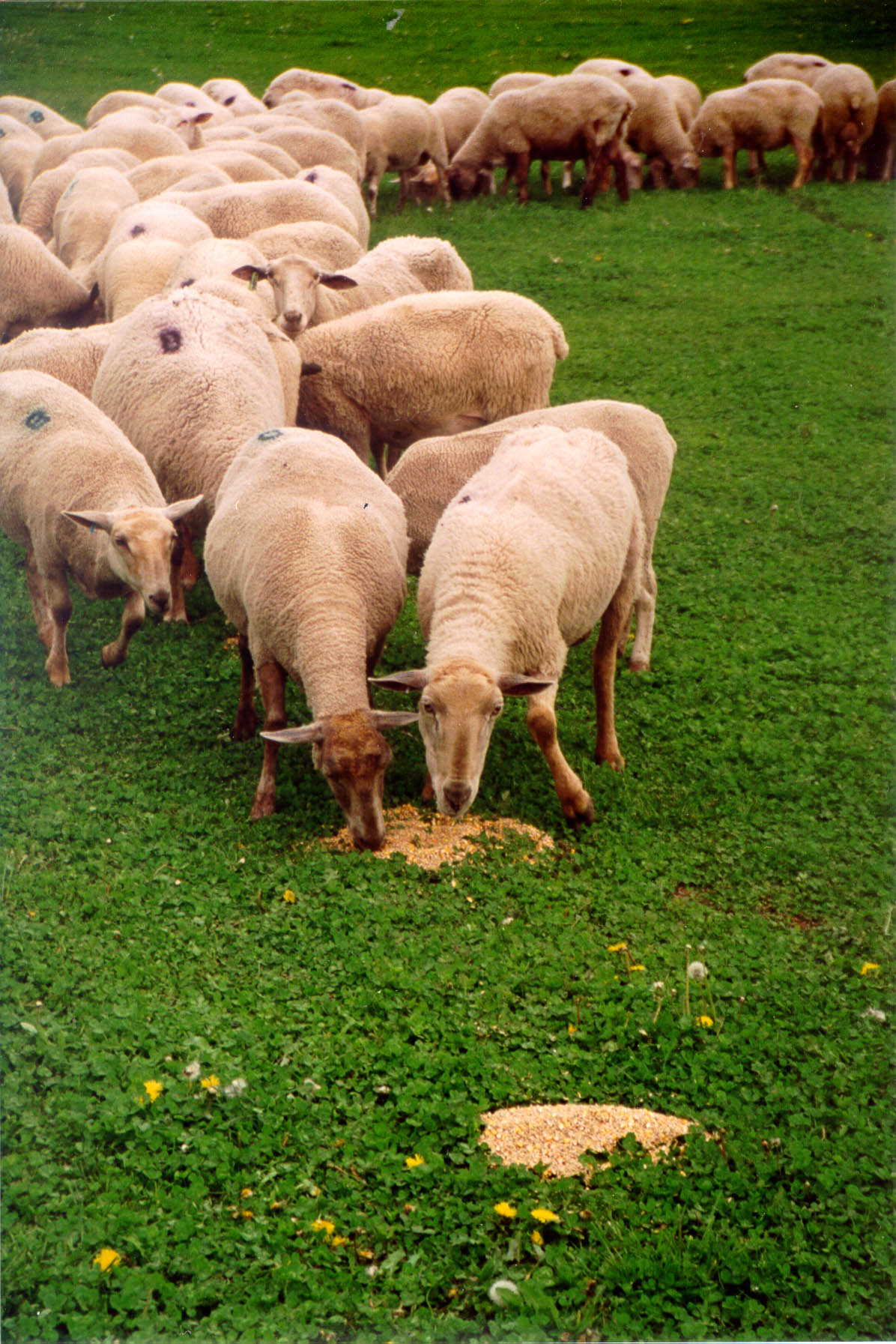Feeding systems for sheep
Learn about feeding systems for sheep. This technical information is for sheep producers in Ontario.
ISSN 1198-712x, published February 2022
Introduction
Choosing a feeding system requires several considerations: labour efficiency, animal diets and other factors such as bunk space, number of head to be fed, as well as mechanical assets and needs (Figure 1). This fact sheet provides information to help you choose a feeding system that will work for your farm situation.
This fact sheet assumes an accelerated breeding and lambing system using prolific ewes. The production system allows for confinement or outdoor housing of the flock.

Feeding rules of thumb
- Make efficient delivery of the forage component a primary goal. Forage feeding forms the bulk of the diet by volume, weight and feeding time, and will be a bottleneck.
- Use a system that enables one person to feed forage with no additional help.
- Incorporate walk-though or drive-through feeders, which are the most time- and labour-efficient.
- Aim for a feeding time (forage only) of no more than 8 seconds per ewe, from storage to delivery completion. This means it takes 800 seconds or 13 minutes and 20 seconds to feed 100 ewes.
- Deliver concentrates even more quickly than forages. Target 1 second per ewe or less of actual feeding time and allow an extra few seconds per animal staging time (for example, the time to fill carts or pails used in feeding).
- Remember that dry ewes (maintenance) require proportionately very little time (feeding and management).
- Employ safe feeding practices. Avoid any feeding system that requires the animals be underfoot or in contact with machinery during forage or concentrate delivery. Such systems increase risk to shepherd and sheep, as well as reduce efficiency.
- Provide ewes with proper feeder space (Table 1) to ensure intake and safety.
| Facility | Specification(s) | Ewes and rams | Feeder lambs |
|---|---|---|---|
| Feedlot | Hard surfaced | 1.4 m2 (15ft2)/head | 0.6 m2 (6.5ft2)/head |
| Feedlot | Soil |
6.5 m2 (70ft2)/head | 2.8 m2 (30ft2)/head |
| Open front shed | Floor area | 1.4 m2 (15ft2)/pregnant ewe 0.93 m2 (10ft2)/dry ewe |
0.6 m2 (6.5ft2)/head |
| Open front shed | Ceiling height | 2.7 m (9 ft) minimum | 2.7 m (9 ft) minimum |
| Slotted floors |
Area per animal | 0.65 m2 (7ft2) | 0.4 m2 (4.3ft2) |
| Slotted floors |
Floor area | 100% | 100% |
| Slotted floors |
Slot width | 19 mm (0.75 in.) | 16 mm (0.6 in.) |
| Slotted floors |
Slat width | 50–75 mm (2–3 in.) | 50–75 mm (2–3 in.) |
| Lambing pens (not slotted) | Floor area | 1.2 x 1.2 m (4 x 4 ft) minimum (claiming pen only) 1.2 x 1.5 m (4 x 5 ft) minimum (lambing and claiming pen) |
N/A |
| Bunk space | Length per head | 400 mm (16 in.) (group feeding) 150 mm (6 in.) (self-fed) |
300 mm (12 in.) (group feeding) 100 mm (4 in.) (self-fed) |
| Bunk space | Height at throat | 305 mm (12 in.) (small breeds) 381 mm (15 in.) (large breeds) |
254 mm (10 in.) (small breeds) 305 mm (12 in.) (large breeds) |
| Storage | Hay | 1.36 kg (3 lb)/head/day (small breeds) 2.27 kg (5 lb)/head/day (large breeds) |
0.91 kg (2 lb)/head/day (small breeds) 0.91 kg (2 lb)/head/day (large breeds) |
| Storage | Grain | 0.15 kg (0.33 lb)/head/day | 0.23 kg (0.5 lb)/head/day (maintenance) 0.45–1.13 kg (1–2.5 lb)/head/day (finishing) |
| Storage | Bedding | 0.34 kg (0.75 lb)/head/day | 0.11 kg (0.25 lb)/head/day |
| Water | Surface area | 0.09 m2 (1ft2)/40 head | 0.09 m2 (1ft2)/40 head |
Source: Adapted from Canada Plan Service, Sheep Housing and Equipment, Plan M-4000.
Planning a system
To plan your feeding system, simulate 1 year’s feeding needs. Include all rations that might be fed. See Table 2 for a sample plan. Your first decision is what format to use to feed forage. Will it be bales or bulk? Silage or dry hay? Assuming bales, are they big or small, round or square? This affects feeder choices and designs, as well as the method of delivery. Forage is assumed to be the cornerstone of the diet, except for lamb rations.
Ration considerations to keep in mind:
- Molasses is recommended in lamb rations to promote intake. Wet molasses is preferred, but dry molasses will also work.
- Supplemental minerals are required in each ration, available either as free-choice, in the supplement pellet or in the ration as a premix. If used as a premix, it will separate with the fines and is not suitable for any feeding system other than bunks/mangers, unless a binding agent is used (for example, molasses).
- The range of crude protein (CP) and total digestible nutrient (TDN) values for the pasture supplementation scheme reflects pasture variability. Understand the forage quality of each pasture being consumed by the sheep.
- Quantities of ration ingredients can only be determined with information on the nutrient content of the forage component of the ration.
- Corn vs. small grains: In many cases, cost determines which grain to use. In general, corn is lower in protein and higher in energy (9% CP and 90% TDN) than barley (12% CP and 82% TDN) and oats (11% CP and 73% TDN). The combination of grain prices and pasture quality affects which grains to use for pasture supplementation and may cause any one ingredient to be removed from the mixture.
Table 2 lists various options available to achieve the recommended crude protein and energy content of supplements for various classes of lambs and sheep. Formulate an appropriate ration to ensure its suitability for a given class of animals.
Diet delivery affects commodity options
Common ration ingredients are shown here. Several variations of feedstuffs are named for each delivery system to allow you to determine ingredient and equipment needs for feeding in the barn or at pastures, so that sheep can effectively consume the diet.
Bunk concentrate feeding system
- soybean meal and distillers’ grains
- mineral premix
- processed grains and by-products
- whole corn
- whole small grains
- supplement pellets
Pasture and ground feeding system
- supplement pellets
- whole corn
footnote 3 - whole small grains
footnote 3
| Animal class | Animal subclass | Typical ration specifications : Overall specifications | Typical ration specifications : Forage content % | Typical ration specifications : Grain content % | Concentrate presentation : TMR | Concentrate presentation : Meal-fed |
Concentrate presentation : Ground-fed |
|---|---|---|---|---|---|---|---|
| Lamb | Up to 29.5 kg (65 lb) | Creep/starter 17%–18% CP 80%–85% TDN |
0–40 | 100–60 | Yes | No | No |
| Lamb | 29.5 kg (65 lb) + | Grower/finisher 15%–16% CP 78%–82% TDN |
0–30 | 100–70 | Yes | Yes | 15%–16% CP 82+% TDN |
| Replacement | Ewe lamb | 14%–17% CP 65%–68% TDN |
65 | 35 | Yes | Yes | 9%–14% CP 80+% TDN |
| Replacement | Ram lamb | 14%–17% CP 65%–68% TDN |
70 | 30 | Yes | Yes | 9%–14% CP 80+% TDN |
| Ewe | Maintenance | N/A | 100 | 0 | N/A | N/A | N/A |
| Ewe | Flushing | 10%–15% CP 68%–70% TDN |
85 | 15 | Yes | Yes | 9%–13% CP 80+% TDN |
| Ewe | Late gestation |
15%–18% CP 68%–75% TDN |
85–60 | 15–40 | Yes | Acidosis risk | 9%–14% CP 80+% TDN |
| Ewe | Lactation |
14%–17% CP 70%–80% TDN |
70–50 | 30–50 | Yes | Acidosis risk | 9%–14% CP 80+% TDN |
| Ram | Maintenance | N/A | 100 | 0 | N/A | N/A | N/A |
| Ram | Conditioning | 10%–15% CP 68%–70% TDN |
85 | 15 | Yes | Yes | 9%–13% CP 80+% TDN |
| Ram | Breeding | 10%–15% CP 68%–70% TDN |
85 | 15 | Yes | Yes | 9%–13% CP 80+% TDN |
Choosing a feeding and mixing system
At a certain farm size, many producers consider mixing their own feed. Consider the following points in deciding whether mixing feed on-farm is economical.
- Calculate the cost of a farm-made diet for the permutations planned. Establish the cost of the commercial alternative. Subtract the two to determine the differential.
- If the differential indicates home mixing may be economical, estimate the tonnage you would mix per year. The more the better, so using the farm mill for many different livestock groups is beneficial.
- Calculate the equipment required above and beyond what is needed for purchased, complete feeds: commodity storage bins, augers, complete diet bins, feed carts plus the mill. Some of the systems to be considered:
- Total mixed ration (TMR) — Silages, hay and grain fed at once. Stationary and mobile mixers available. TMR mixers work in a batch-mixing manner. They require specialized feeding arrangements (drive-through feeders for mobile units, conveyor belts or wagons for stationary units). Daily time requirement includes loading, mixing and dispensing.
- Tractor drawn mix-mills — Large batch mixers that can process dry hay by grinding it into concentrate rations. They are run off power-take-off (PTO) power and have their own dispensing auger. These allow bins to be filled at one or more locations. Daily time requirement includes loading, mixing and dispensing.
- Stationary volumetric mills — Feed proportioners: feed ingredients are stored in overhead bins and flow by gravity into separate compartments located on top of a stationary mill. They produce a steady flow of the desired ration by controlled ingredient flow rate but require calibration upon receiving a new commodity. Furthermore, they can only be used for concentrate diets. Daily time requirement includes bin level checks, timer setting and dispensing.
- Blending boxes — The same stationary principle as the Stationary Volumetric Mills but have no motorized parts. They are based on flow rates through slides, are probably less accurate, have no potential for rolling or grinding and lack self-contained augers. Daily time requirement includes bin level checks, supervised mixing and dispensing.
- Decide on an appropriate amortization period for the extra equipment. It should reflect the lifetime of the machinery (5–10 years).
- Does the differential multiplied by the tonnage over the amortization period cover the entire farm mixing related cost? Remember to factor in your additional labour costs.
Diet supplementation for ewes grazing pasture
Many producers use lightweight mangers located in the pasture area and deliver feed to the manger in pails or bags. Although this strategy may work for a small group of animals, the labour and physical risk to the shepherd usually hinders the success and life span of this practice in larger animal groups.
An overlooked fact is that sheep, because of their mouth structure, can retrieve feed particles from within the pasture sward. Provided the feed is delivered on a clean surface (clean grass, sod or snow), ewes will very quickly and effectively learn how to thoroughly clean up the feed mixture (Figure 2).

The larger the feed particle, the better the retrieval by sheep from among the pasture plants. Whole cereal grains and corn work well as supplements because sheep ruminate (regurgitate and chew) these grains, slowing the release of their energy.
While pelleted diets can be used, pellets contain processed feed and are susceptible to wet conditions. However, pellets are the only way to deliver minerals, pharmaceuticals and any other granular material. Suitable feeds for ground feeding include whole shelled corn, whole cereal grains, whole soybeans (raw and roasted), pellets (as large as possible) and any other nutritious feed that can withstand delivery and ground contact outdoors.
Methods of pasture supplement delivery include:
- Pails — The supplement is manually poured on the ground from pails. Although this is the simplest delivery method, it’s difficult to control the flow rate, and consequently, maintain appropriate “bunk space” and control the amount of feed in front of any given ewe. It also has potential safety issues for the person carrying feed among hungry sheep, which has been known to result in injury.
- Mobile gravity flow hopper and chutes — Bins with a controlled opening allow the feed to slide out at a pre-set rate. There are various designs, but they are typically homemade and mounted on or pulled behind all-terrain vehicles (ATVs), tractors or other vehicles. The feed is distributed in a continuous line from where feeding begins, which creates a risk of the ewes fouling the feed as they line up to eat.
- Mobile dispenser units (snack wagons) — Advanced mobile units, either commercially purchased or homemade, that dispense feed in discrete piles around which ewes form circles. This prevents the fouling of the supplement (Figure 3). Typically, they use a wheel principle, where the predetermined amount is dropped at the rate of 1 amount per revolution. Ideally, the tire (drive) circumference allows 2 ewe lengths between piles.

Conclusion
In choosing a feeding system, several factors must be considered. Most important are labour efficiency, safety and cost. Using a feeding or supplementation system that is fast, effective and safe will ensure the proper feed is delivered at the proper time. This in turn will improve animal performance and flock success.
This fact sheet was updated by Christoph Wand, sustainability specialist and Erin Massender, small ruminant specialist, Ontario Ministry of Agriculture, Food and Rural Affairs (OMAFRA).
Footnotes
- footnote[1] Back to paragraph Use soil-surfaced feedlots only where annual precipitation is less than 508 mm (20 in.). With soil surface, provide a paved feeding strip adjacent to each feed bunk. This paved strip should be at least 1.83 m (6 ft) wide, or as wide as the tractor used for cleaning, and the strip should slope at 42.3 mm/1 m (0.5 in./ft) away from the feed bunk.
- footnote[2] Back to paragraph An alternative to slotted floors, for ewes, rams or lambs is 25.4-x-50.8 mm (1-x-2 in.) 10-gauge expanded and flattened metal mesh. Expanded metal mesh floors may be covered with a solid panel to retain bedding for lambing.
- footnote[3] Back to paragraph Free choice mineral premix required if supplement pellets are not used.
- footnote[4] Back to paragraph Meal-fed: when grain is fed all at once in a bunk, such as slug feeding, pail feeding.
- footnote[5] Back to paragraph Ground-fed: when grain is fed all at once, but it is delivered on the ground.
- footnote[6] Back to paragraph Acidosis risk